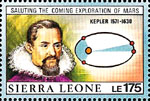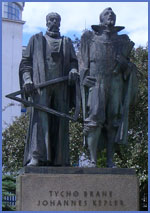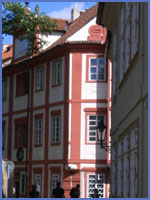Back to . . .
 Curve Bank Home Curve Bank Home
NCB Deposit
# 76
Jeffrey M. Groah
Montgomery College
Conroe, Texas
|


|
A Power Point Presentation and
Animation
The Conics and Stereographic Projection
To Infinity and Beyond
|
 Click below to see
the Power Point slide show.
Click below to see
the Power Point slide show.
|
|
Power
Point
Slide Show
References
Johannes Kepler said, “A parabola is an
ellipse with a focus at infinity.” On its face, this statement is
nonsense. What does it mean for a focus to be “at” a point that is not
defined? In this animation, points on the plane are associated with
points on a sphere by stereographic projection. The north pole of the
sphere corresponds to the point at infinity. This is the one point
compactification of the plane. Curves in the plane correspond to curves
on the sphere. In particular, a family of ellipses in the plane with
one focus that tends to infinity is displayed. On the sphere, when the
focus is at the point at infinity, the curve corresponds exactly to a
parabola in the plane. The focus on the sphere is then sent beyond
infinity, over the top. The corresponding curves in the plane are
hyperbolas. In this sense, hyperbolas are ellipses where one focus has
been sent to infinity and then back from the other side, just as Kepler
described. Using the one point compactification, we can make sense of
Kepler’s descriptions of the conic sections.

|
For more
animations please see
< http://jgroah.nhmccd.cc/index.htm
>.
For more on Kepler please see
< ..//birthdayindex/dec/dec27kepler/dec27kepler.htm
>.
|
Note:
There are many spellings of the name of Pavel Sergeiivich Aleksandrov
(1896-1982) as it must be translated from the Cyrillic
alphabet. In researching this material we found Alexandroff and Alexandrov as well as Aleksandrov. Aleksandrov is used by Gardner,
Katz and Weisstein.
| Howard
Eves, An Introduction to the History of Mathematics, 6th ed., Saunders
College Publishing, p. 324. |
R. J.
Gardner, "Geometric Tomography." Not. Amer. Math. Society, 42, 422-429, 1995.
|
Victor
J. Katz, A History of Mathematics,
2nd ed., Addison Wesley Longman, 1998, p. 832.
Katz
writes of the chain of famous names associated with the birth of
Algebraic Topology. Noether, Aleksandrov, Eilenberg and Mac Lane
are
all joined in this whole new 20th century field of study.
"When in the course of our lextures (in
Göttingen in 1926 and 1927) she first became acquainted with a
systematic construction of combinatorial topology, she immediagely
observed that it would be worthwhile to study directly the groups of
algebraic complexes and cycles of a given polyhedron and the subgroup
of the cycle group consisting of cycles homologous to zero ...."
Aleksandrov's memorial to Emmy Noether
(1882-1935)
|
|
|
Eric W.
Weisstein, CRC Concise Encyclopedia
of Mathematics, CRC Press, 1999.
|
|
|
Kepler
introduced the word "focus" into the geometry of conics. Indeed,
it has been written that if the Greeks had not perused the conics,
Kepler could not have superseded Ptolemy. But he is primarily
remembered for his three laws, a cornerstone of astronomy.

Kepler
is honored on many stamps.
|
"I
am writing a book for my contemporaries - or does not matter - for
posterity. It may be that my book will wait for a hundred years
for a
reader. Has not God waited 6,000 years for an observer?"
Johannes
Kepler, Harmony
of the Worlds, 1619
|
|
|

Both Brahe
and Kepler are honored in Prague . . . .
|

and for a time, both
lived on this same street.
|
|
|
|